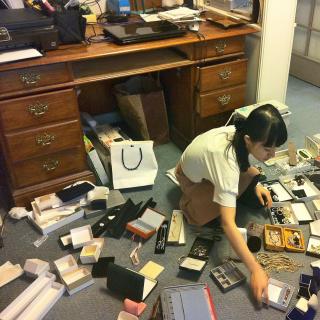
介绍:
想成为我们的主播,欢迎加微信 xdfbook 投稿。
一段美文,一首英文歌,或是一点生活感想,全由你做主。
《断舍离的经济学智慧》
The Economics of Tidying Up
“In this book, I have summed up how to put your space in order in a way that will change your life forever.”
This is the ambitious first sentence of Marie Kondo1)’s best-selling manifesto, The Life-Changing Magic of Tidying Up. Direct and devoid of clutter, this sentence rings true to her philosophy. Unlike most self-help books, there are no extraneous words, no pandering2)—the lack of “wink wink” gesturing reads as an appealing, authentic statement.
In the introduction of her book, Kondo quantifies the power of her advice—she estimates that she’s helped her clients dispose of no fewer than a million items. This number is astonishing, but a key element of Kondo’s argument is that hardly anyone is aware of how many items he or she owns. Most wouldn’t even notice if some of those items are gone, she argues, but the problem is that throwing things out and putting belongings in the right place requires jumping through some psychological hoops3).
Why do people have so much trouble throwing things out? Turns out, the answer lies in people’s heads. Running through Kondo’s best advice and most of her book is the argument about the anxiety-induced limits of human decision-making. Seeing as an entire branch of economics studies exactly that, it’s no wonder that economists have a particular interest in her advice. Financial Times columnist Tim Harford agrees that Kondo’s methods are not only intuitive, but compelling to economists. Harford says that the clutter that piles up in apartments is a product of people’s cognitive blunders4).
In my reading and practice of the eponymous5) “KonMari Method,” I found that Kondo does implicitly touch on some important behavioral economics concepts and cognitive biases that prevent us from being tidy. She takes strong stances against these irrational mental habits that govern us. In other words, I think the reason Kondo-mania continues is because she has actually hit upon some good solutions to deal with these pervasive mental fallacies.
For example, Kondo aptly6) attacks what’s called the sunk-cost fallacy7). The term “sunk cost” applies to payments (of time or money) that have already occurred and thus can’t be recovered. The money’s spent, an investment has been made, and it makes people irrational because it seems a waste to not use something that one has poured resources into. The irrationality of this thinking is that people ignore whether an item they own is still useful to them, and whether they’ll actually use or resell it. In my tidying efforts, I find that the sunk-cost fallacy hits harder for new items, because unused items retain more value in resale. Kondo’s advice is to get rid of them, and her faith in keeping only the things that “bring us joy” addresses the economic concept of opportunity cost8): The mental and physical toll of keeping an unused item around is greater than throwing it out.
Harford, the FT columnist, found that the KonMari Method addressed other economic concepts, such as the status-quo bias9) and diminishing returns10). He writes: “Status quo bias means that most of your stuff stays because you can’t think of a good reason to get rid of it. Kondo turns things around. For her, the status quo is that every item you own will be thrown away unless you can think of a compelling reason why it should stay.” I found that this new status quo was particularly helpful in discarding paper, namely because I couldn’t find a compelling reason to hang onto all my credit card statements. They came in the mail, and I kept them just because that’s what I always did. Kondo’s method sets a new status quo: throw them out. My boyfriend and I took this one step further, cancelling our paper statements for credit cards and utilities.
I found it a bit harder to put Kondo’s wariness of diminishing returns—the idea that the more you have of something, the less valuable each successive item is—into practice. Perhaps it was because this most applies to the items I have the hardest time throwing out: clothes. Kondo’s method of putting all of whatever-item-is-being-evaluated on the floor not only overwhelmed me, but it also made me anxious. It reminded me that the reasons I have so much clothing are that firstly I want to be prepared in case I don’t have time for laundry in a given week, and secondly that the neurological pleasure of cheap fashion is very scary and real. Because of my laundry concern, the idea of having three pairs of identical black work pants seems pragmatic to me. I could see the diminishing returns of having 20 T-shirts, so I discarded the ones that don’t fit.
……
“在这本书中,我总结了如何使你的空间整齐有序的方法,这种方法将永远地改变你的生活。”
这是《怦然心动的人生整理魔法》一书雄心勃勃的开篇词。这本宣言式的书是近藤麻理惠最畅销的作品。书中开篇的这句话开门见山,干净利落,真实地道出了她的理念。与大多数自助类书籍不同,这本书没有废话,不迎合读者——书中没有那种“讨好”式的语句,读起来像是真正的宣言,很吸引人。
在这本书的前言部分,近藤通过数字来说明她所提建议的影响力——据她估计,她帮助客户处理了不少于一百万件物品。这个数字很惊人,但是近藤的观点中关键的一点是,几乎没有人意识到自己有多少件物品。近藤说,大多数人甚至都不会注意到这些物品中的一些已经不在了,但问题在于,要丢弃东西以及把自己的物品放在正确的地方,这需要我们经受心理上的磨练。
为什么人们扔东西会这么难呢?原来,问题出在人们的思想上。焦虑会导致人们在做出决定时受到局限,这一论点是近藤最佳建议的核心,贯穿了她那本书的大部分章节。经济学有一个完整的分支是观察,该分支的研究对象正在于此。难怪那些经济学家会对近藤的建议特别感兴趣呢。《金融时报》的专栏撰稿人蒂姆·哈福德认为,近藤的方法不仅简单好用,而且令经济学家着迷。哈福德说,公寓里堆砌的杂物是人类认知错误的产物。
在阅读《怦然心动的人生整理魔法》以及实践与书名同名的方法的过程中,我发现近藤的确隐约触及到了一些重要的行为经济学概念和认知偏见,正是这些概念和偏见阻碍我们变得井井有条。近藤强烈地批判了这些支配我们的非理性思维习惯。换句话说,我认为近藤一直风靡的原因就在于她真的找到了解决这些普遍心理误区的好方法。
例如,近藤巧妙地抨击了所谓的沉没成本误区。“沉没成本”这个词指的是那些已经发生并且无法收回的付出(比如时间或金钱)。钱花了,投资做了,对于这些已经投入资源的东西,如果不用似乎就是浪费,因此人们会变得不理性。这种观念的不理智之处在于,人们忽略了他们所拥有的物品对自己来说是否还有用,以及他们以后是否真的会用还是会转卖掉。在我努力整理的过程中,我发现沉没成本误区在新东西上体现得尤为明显,因为没用过的东西在再销售时更有价值。近藤的建议是彻底摆脱这些东西。她的理念是只留下那些“让我们怦然心动”的东西。该理念应对的就是机会成本这个经济学概念:相比于扔掉一件无用的物品,保留它所造成心理伤害和实际损失要更大。
《金融时报》专栏撰稿人哈福德发现近藤麻理惠的方法也触及了其他经济学概念,例如维持现状偏见和边际效用递减规律。他写道:“维持现状偏见的意思是,大部分东西得以保留,是因为你找不到一个正当的理由来扔掉它们。近藤把这个道理反过来说。对她来说,维持现状就是你拥有的每一件物品都将被扔掉,除非你能想到把它留下的迫切理由。”我发现这种新的维持现状理念对丢弃纸张大有益处,因为我找不到一个迫切的理由来保留所有的信用卡对账单。这些账单是寄到信箱里的,我留着它们仅仅是因为我一直都这么做。近藤的方法设立了一种新的现状:扔掉它们。我和男友的做法则更进一步:取消了信用卡和水电气的纸质账单。
近藤提醒要谨防边际效用递减规律,即你拥有的一种物品的数量越多,每个单件物品的价值就会逐渐越少。我发现要将这一点付诸实践有点难。也许是因为这一规律主要适用于丢弃对我来说最难丢弃的东西——衣服。近藤的方法是把所有要接受估值的物品摆放在地板上,这既让我感到不知所措,也使我感到焦虑。这让我想起我之所以有这么多衣服是因为:首先,我要多准备一些衣服以防在某一周内没有时间去洗衣服;其次,廉价时装带来的神经兴奋是非常惊人且真实的。因为担心洗衣服的问题,所以拥有三条一模一样的黑色工装短裤对我来说似乎挺实用的。但我也体会得到拥有20件T恤的边际效用递减规律,所以那些不合身的T恤我都扔掉了。
……
文章摘自:《新东方英语》杂志2016年8月号
大家还在听

